“Little Red Riding Hood” tomatoes, popular among summer residents: description of the variety and instructions for growing it yourself
Every owner wants his harvest to receive compliments and his efforts in the garden to be rewarded with good feedback. But the taste of tomatoes will depend not only on experience and talent. The right variety is half the battle.
Let us introduce you to a find among the tomato variety - the “Little Red Riding Hood” variety. We will tell you in detail about the features of care, share tips on how to prepare seedlings, and also share the opinion of tomato growers about “Little Red Riding Hood”.
Description of the variety
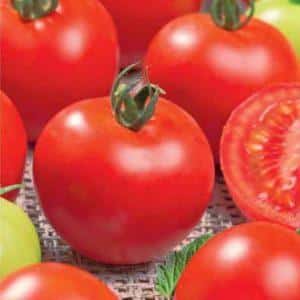 The Red Riding Hood tomato is one of the types of salad tomatoes. It comes from Germany, hence its name "Rotkäppchen", which translates from German as “little red riding hood.” This variety is loved by many gardeners, as it is unpretentious in cultivation and is well suited for planting in any place.
The Red Riding Hood tomato is one of the types of salad tomatoes. It comes from Germany, hence its name "Rotkäppchen", which translates from German as “little red riding hood.” This variety is loved by many gardeners, as it is unpretentious in cultivation and is well suited for planting in any place.
The Red Riding Hood tomato is characterized by early ripening and high resistance to diseases, ease of care.
Features of the variety
The name of the tomato variety comes not from the color of the fruit, but from the characteristics of their growth. A cluster of tomatoes is formed at the top of the bush, giving the impression of a small red head.
Sweet, fleshy fruits ripen on the plants. This determinate tomato is characterized by medium branching bushes, the height of which is about 40 cm.
Fruit characteristics, yield
Red Cap tomatoes have a rounded-flattened shape, with a smooth surface. The stalk has ribs.The surface of the fruit is smooth. The skin is thin, ripe tomatoes are red-orange in color. The pulp is juicy, fleshy and sweet.
This is not just an early ripening tomato, but even a super early ripening one. Sometimes less than three months pass from the emergence of seedlings to the first harvest. One plant can produce about 1 kg of fruit. On average, about 2-3 kg of tomatoes are obtained from one square meter.
Note. To increase yield, shake the plant a little during flowering. This guarantees better pollination.
Preparing seedlings
It is better to grow the variety through seedlings. Seeds begin to be planted at the end of March. If you plan to transplant seedlings into greenhouse, then it is better to start sowing in the last days of February.
Seed preparation
To prepare, seeds are usually kept in a light pink solution potassium permanganate. After this, the planting material should be germinated. This is done as follows.
Warm water is poured into a small container. Seeds are placed on a cotton napkin. After this, cover the material with a wet napkin and send it to a warm and bright place. After about two days, the seeds germinate, after which they are ready to be planted in the ground for seedlings.
Selecting container and soil
To grow tomato seedlings, you can use either a common container or individual cassettes, cups or peat tablets.
The soil for tomato seedlings should be light and fertile. It is recommended to mix the soil with sand and peat. You can buy ready-made substrate in the store.
Let's move on to sowing
Holes are made in the soil 1.5 cm deep at a distance of 3 cm. One grain is placed in each hole, sprinkled with earth and watered. The container is covered with film and sent to a warm place.
The first shoots usually appear after 5 days, provided that the temperature was maintained above +18°C. After mass shoots appear, the film is removed and the container is placed on the windowsill.
Seedling care
Caring for seedlings during this period consists of periodically moistening the soil, but this should be done infrequently, as the soil dries out.
Transplanting tomatoes into open ground begins only when the weather is consistently warm. At night the air temperature should not fall below +15 degrees.
Features of cultivation
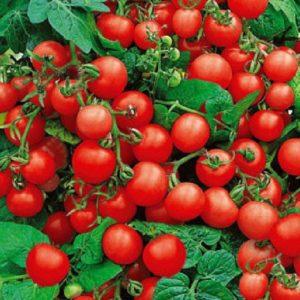 It is advisable to send Red Riding Hood tomato seedlings to the area where the cabbage crop was harvested, peas, herbs, pumpkin, garlic or onions. You cannot plant tomatoes after eggplants, potatoes, sweet peppers, and corn. Choose an area that is warmed by sunlight and protected from drafts.
It is advisable to send Red Riding Hood tomato seedlings to the area where the cabbage crop was harvested, peas, herbs, pumpkin, garlic or onions. You cannot plant tomatoes after eggplants, potatoes, sweet peppers, and corn. Choose an area that is warmed by sunlight and protected from drafts.
It is better to prepare the site in the fall. Dig the ground to a depth of 30 cm and add fertilizers, for example, humus (5 kg per 1 sq. m.), bird droppings (1 kg per 1 sq. m.), wood ash (100 g per 1 sq. m.). Among mineral fertilizers, choose potassium salt (25 g per 1 sq. m).
Landing
Before you start planting, you need to prepare the bed. The soil for planting tomatoes is dug up to 20-25 cm, adding humus to 1 square meter. m 0.5 buckets. They make furrows. After this, holes are formed approximately 20 cm deep. Next, you need to pour a little warm water into each hole to moisten the soil.
The seedlings are carefully placed in the hole and covered with earth, carefully compacted. It is necessary to water the plants again the next day. Next, the seedlings must acclimatize and take root. During this period they need good watering.
Aftercare
Caring for these tomatoes does not require any special skills. It comes down to timely watering, as well as loosening and mulching the soil surface. You can use freshly cut grass, straw or young weeds as mulch.
Feeding Plants should be started a week after the seedlings take root. Foliar fertilizers (urea solution, boric acid, potassium monophosphate) are suitable for this.
Since the bush is short and compact (reaches about 40 cm in height), this variety does not need staking. You can also refrain from forming a bush and pinching. Thanks to these qualities, the variety is excellent for gardeners who cannot pay much attention to plant care.
What to pay attention to
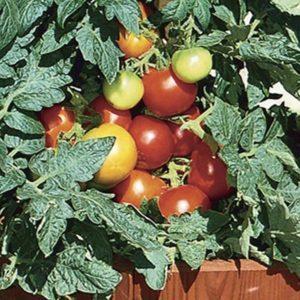 Since Red Riding Hood tomatoes are unpretentious, caring for them will not cause much trouble.
Since Red Riding Hood tomatoes are unpretentious, caring for them will not cause much trouble.
Plants need to be watered abundantly, but not too often. The frequency of watering depends on the humidity of the air and soil. It is optimal to wait until the soil dries.
You need to pour water strictly at the root. When the first color appears, intensity glaze worth reducing. If you don't follow this advice, you risk a watery and tasteless harvest.
Since Red Riding Hood tomatoes love oxygen-rich soil, the soil needs to be loosened from time to time. But this should be done only superficially, so as not to harm the root system of the plants.
Diseases and pests
Red Riding Hood tomatoes are disease resistant and pests. But sometimes they can affect this variety too. Let us briefly describe the main problems that a gardener may encounter when planting this variety of tomatoes on his plot.
One of the diseases that can threaten tomatoes is late blight. It is necessary to remove the leaves affected by the disease, and treat the plant itself with preparations containing copper, for example, copper sulfate.
Some insects can also threaten your crops, such as:
- spider mite This is a small spider, its color varies from green to brownish-brown, most often hiding on the back of the leaf. It feeds on the sap of green plants, leaving behind dry skeletons entwined with cobwebs;
- thrips These are small oblong bugs of black, gray and brown colors. The size depends on the species and ranges from 0.5 mm to 1.5 cm. They dehydrate leaves, flowers and fruits, and also contaminate them with secretions;
- whitefly This is a small butterfly that causes significant damage to the plant. Both the larvae and the adult use plant sap as food, sucking it from plant tissue;
- aphid. This parasite feeds on plant juices, drying them out and leading to death.
To combat them, you can use herbal preparations. For example, you can use an infusion of celandine for spraying. It is prepared as follows: 0.8 kg of fresh green mass of celandine (or 0.2 kg of dry grass) is infused for 12 hours in 10 liters of water. Warm soapy water will also help get rid of aphids. The solution should be sprayed on all parts of the plant, especially paying attention to places where insects accumulate. In extreme cases, insecticides will help get rid of pests.
Important! It is forbidden to use insecticides after the fruit has set.
We grow tomatoes in an open garden and in a greenhouse
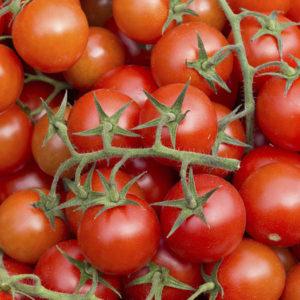 Tomatoes of this variety are not picky. In greenhouse conditions and in open ground they require almost identical care. There are several nuances that are worth paying attention to.
Tomatoes of this variety are not picky. In greenhouse conditions and in open ground they require almost identical care. There are several nuances that are worth paying attention to.
Depending on the further “habitat” of the bush, planting times differ. The seedlings are transplanted into the greenhouse starting in mid-May, and into an open garden bed at the beginning of June.
In the garden, Red Riding Hood tomatoes are best placed near the following crops: parsley, zucchini, cauliflower, dill, cucumbers or carrots. This kind of neighborhood would be ideal. It is important not to plant these tomatoes where potatoes, eggplants or sweet peppers previously grew.
It should be noted that pests threaten plants in a greenhouse more often.
Another fact about these tomatoes will please gardeners: The plant is suitable for planting not only in greenhouses, but also at home on a balcony or windowsill. Thanks to its compactness and unpretentiousness, the bush grows and bears fruit even in unfavorable conditions.
Harvesting and application
In the photo there is a Red Riding Hood tomato.
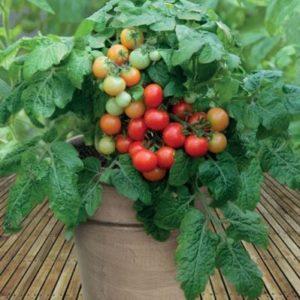 The first harvest of Red Riding Hood tomatoes is harvested 95-100 days after planting. The fruit sizes are small but even. Vegetables are round in shape and neat. Ripe fruits have a rich and deep bright red hue. Sometimes it even appears orange.
The first harvest of Red Riding Hood tomatoes is harvested 95-100 days after planting. The fruit sizes are small but even. Vegetables are round in shape and neat. Ripe fruits have a rich and deep bright red hue. Sometimes it even appears orange.
Since the skin of Red Cap tomatoes is tender and thin, these tomatoes are not suitable for transportation.
Most often consumed fresh. Tomatoes of the “Little Red Riding Hood” variety are considered salad tomatoes, but are suitable for making soups, sauces, purees, and juices. This variety is also used for canning.
Advantages and disadvantages of the variety
Having studied the “Little Red Riding Hood” tomato variety, we will briefly dwell on its advantages and disadvantages.
So, the “advantages” include:
- resistance to temperature changes;
- compactness; plant, does not require extra space;
- resistance to diseases characteristic of tomatoes;
- pinching of bushes may not be performed;
- taste qualities of fruits;
- behave well both in open ground and in a greenhouse;
- early maturation;
- minimal care, excellent response to nutritional formulations.
On the negative side, it can be noted that they:
- are not subject to long-term storage;
- do not tolerate transportation well.
Farmer reviews
If you still have doubts, read the opinions of those who have already practiced growing these tomatoes.
- Oleg, 39 years old, Kuban. “I really like growing Little Red Riding Hood. She has been on my site for three years now. I like to marinate. The whole family is delighted with my pickles. They look super appetizing in a jar.”
- Sergey 49 years old, Chelyabinsk. “The variety fully met expectations - what was stated on the packaging turned out to be so. The bushes are small, and the fruits, by the way, are also a little larger than Cherries. But the bushes were sprinkled with small tomatoes. I will continue to plant them in the future, since they survived the winter in jars very successfully, not one of them became cloudy.”
- Olga, 59 years old, Murmansk. “It was the first time I planted something on the balcony, but I’m glad that I chose Little Red Riding Hood based on the advice. I planted a seed in a regular flower pot to test it. A small bush grew up as a decorative bush, but as a result it was completely covered with tomatoes.”
Conclusion
Red Riding Hood tomatoes can please gardeners. After all, preparing seedlings and subsequent plant care does not require special skills, and due to resistance to diseases and pests, every gardener can be calm about his harvest. But the harvest will be not only tasty, but also rich.